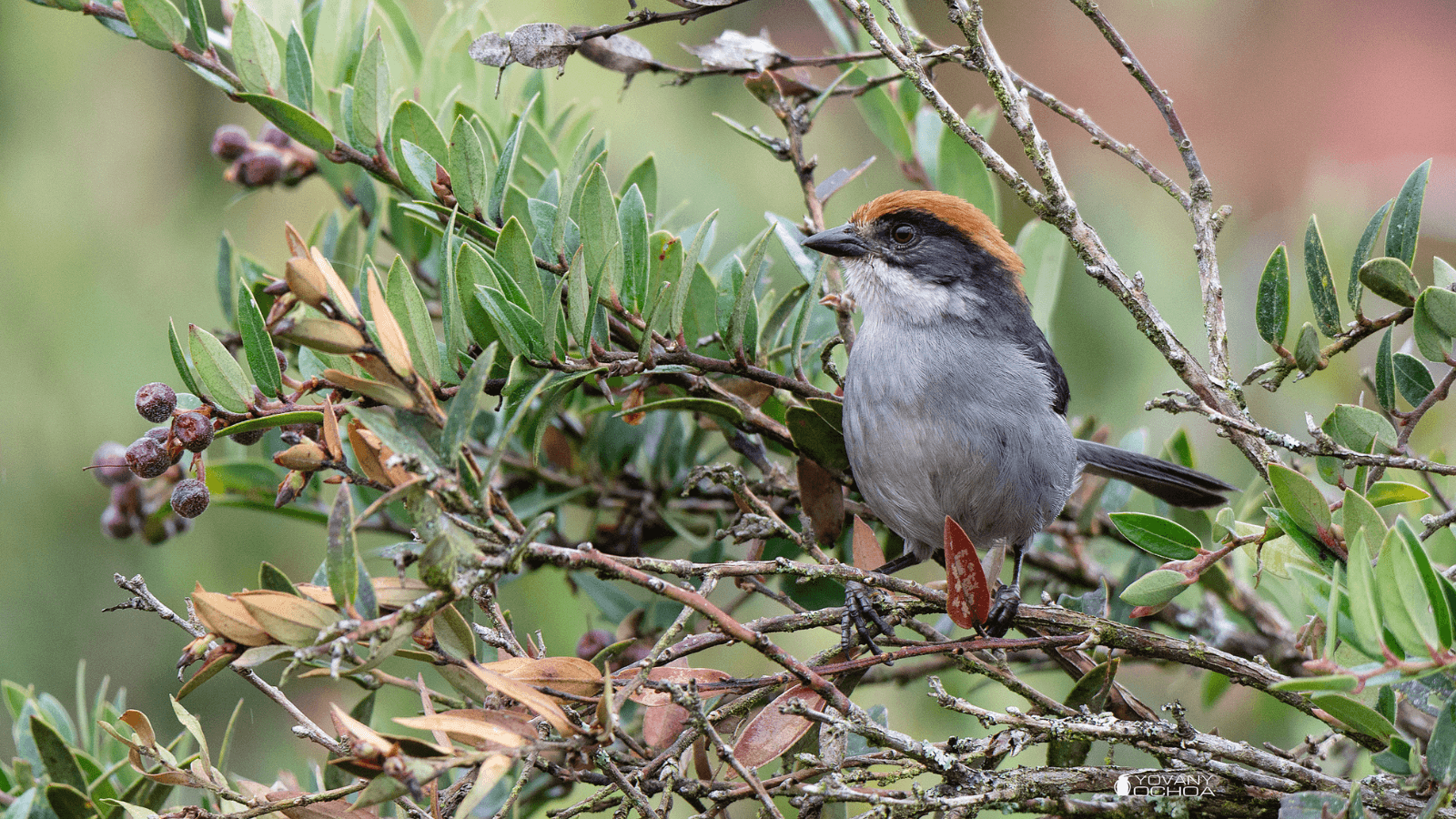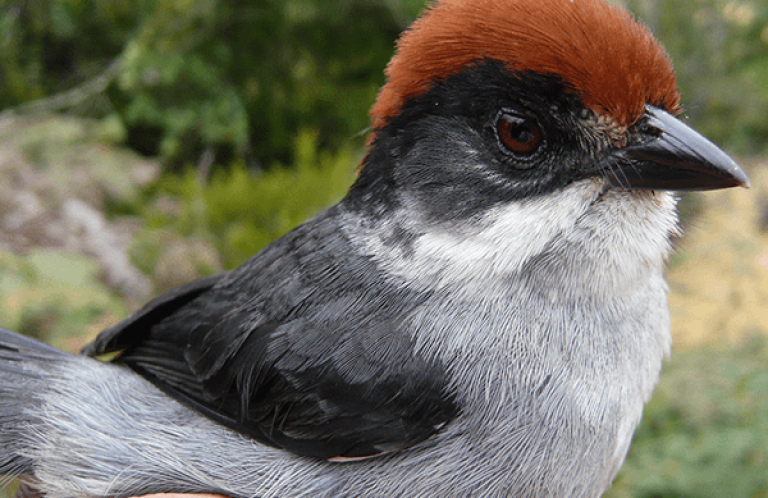New Reserve in Colombia will Protect Critically Endangered Antioquia Brushfinch

More than 15 years after it was first described by scientists and five years after its rediscovery in the wild, the Antioquia Brushfinch now has a private reserve to call its own.
The 880-acre (356.5 hectare) Antioquia Brushfinch Reserve north of Medellín, Colombia, acquired with the support of American Bird Conservancy (ABC), Conserva Aves, and Rainforest Trust, is the first dedicated entirely to protecting this Critically Endangered species. With fewer than 100 individuals remaining and increasing pressure on their native scrub habitat from agricultural expansion and climate change, the reserve could be the key to saving a species that almost disappeared before researchers knew it existed at all.
“The area where the brushfinch is located is highly productive, so there's a lot of cattle ranching and agriculture in the surrounding area,” said Eliana Fierro-Calderon, International Conservation Project Officer for ABC. “The fact that we now have this stronghold for this species is perfect — it's the right moment to create a reserve.”
An Unlikely Find

The Antioquia Brushfinch owes its survival today, in part, to a series of happy accidents. The first occurred in 2007, when an ornithologist sifting through a collection of museum specimens noticed something amiss. Three birds labeled as “Slaty Brushfinch,” a widespread sparrow-like bird native to humid Andean forests, did not look like the other Slaty Brushfinch specimens.
These individuals had the same signature red cap, but they were paler, without the wide streak of black feathers that extends from either side of a Slaty Brushfinch's beaks like a handlebar mustache. The three individuals were in fact a different species — one not yet described by scientists. Unfortunately, information about their geographical origin was vague, and only one had a date: 1971, more than 35 years prior.
Expeditions to the Antioquia department of Colombia to find the bird alive in the wild came up empty-handed. When more than a decade passed with no sighting of the bird, scientists feared it was extinct. Then, in 2018, a keen-eyed engineering student living in San Pedro de los Milagros noticed a bird on his way to Sunday mass that looked just like the Antioquia Brushfinch in his field guide, which noted the bird may be extinct.
He snapped a picture and sent it to a biology professor, who sent it to an ornithologist who decided to travel to the area and take a look for himself. The team relocated the bird and confirmed what they had hoped — it was an Antioquia Brushfinch, alive in the wild 47 years after its last documentation.
In the years following the rediscovery, ABC supported searches in the surrounding areas, which identified more individual birds. Researchers learned that unlike the forest-loving Slaty Brushfinch, the Antioquia Brushfinch prefers scrubby habitat with short trees. In these scrubby patches, the birds like to forage on the ground for seeds and fruits, traveling alone or in pairs.
Subsequent expeditions revealed some troubling information as well — only a handful of these birds remained, and the specific habitat they favored was rapidly being cleared for grazing and farmland. In the few years since the first searches in 2018 and 2019, 300 acres (121 hectares) of prime Antioquia Brushfinch habitat have been cleared, including a portion of the site of the rediscovery. Without steps to save the habitat that remained, the species would surely go extinct.
A Safe Haven for a Dwindling Species

ABC and partners have taken a number of steps to help save Antioquia Brushfinch habitat since its rediscovery. Three searches supported by ABC and organized by local partner SalvaMontes helped pinpoint important areas for protection and enable an accurate population estimate. To date, the species has been found in 25 locales, most clustered around a small area north of Medellín known as Altiplano Norte de Antioquia. The latest search estimated a total population of 108 individuals for the species.
ABC has also supported outreach to local farmers to implement a participatory conservation strategy that incentivises protecting brushfinch habitat. In 2021, ABC helped put 471.96 acres (191 hectares) of land under conservation agreements with three landowners within the bird's range.
All of these steps have been a huge help to the species, but with Antioquia Brushfinch habitat disappearing fast, the additional protection provided by private reserves is critical to the species' survival.
“ABC has always wanted to have a reserve for the species because it is very range-restricted and this is a heavily agricultural area,” said Fierro-Calderon. “There are places where the species was found four years ago where they don't exist anymore, so there has been this urgency of, ‘We need to do something.'”
ABC has been working with local partner SalvaMontes to locate good potential locations for a reserve that protects intact habitat within the brushfinch's range. Late in 2021, the partnership finally found a good fit. When they went to talk to the landowner, they learned that the neighbor was also looking to sell. A search of the new property turned up even more brushfinches.
In 2022, ABC supported the purchase of the two properties to create the Antioquia Brushfinch Reserve, which will be co-managed by SalvaMontes and Neotropical Innovation. While the entire reserve is just a little bigger than New York City's Central Park, it is home to high-quality habitat bursting with life. The scrub habitat is also home to the Black-throated Flowerpiercer (an endemic subspecies), a potential new species of Antpitta, and a number of imperiled native plant species. Paramo, a kind of native grassland habitat, is also protected within the new reserve.
While ABC was working towards the land purchase with SalvaMontes, there was another piece of good news. An existing private reserve located nearby, Guanacas Reserve, had discovered that there was an Antioquia Brushfinch population just outside its borders. Fundación Guanacas Bosques de Niebla, the organization running the Guanacas Reserve, contacted ABC to ask for support to expand the reserve to include the nearby brushfinch habitat. This January, the Guanacas Reserve officially added 145 acres (55 hectares) of land, bringing its total area 2,058 acres (833 hectares).
More Work Ahead
ABC and partners are hoping that the new reserve and Guanacas expansion will provide the species with the space it needs to avoid extinction and even expand its population. This strategy has already worked elsewhere. A reserve created to save the related Pale-headed Brushfinch, which was rediscovered in Ecuador in 1998, helped that species grow from a couple dozen birds to more than 200.
However, the work isn't done yet. The small Antioquia Brushfinch population is still at risk of being divided into even tinier subpopulations due to habitat fragmentation outside of the protected areas. There is a stretch of unprotected habitat that divides the new Antioquia Brushfinch Reserve, for instance. (ABC hopes to make this habitat into a private reserve or conserve through other means in the long run.)
In addition, a nearly 3,000-acre (1,200-hectare) property containing good brushfinch habitat recently changed hands and is now being cleared at a rate of nearly 150 acres (60 hectares) per week, showing the urgency of the need to protect remaining brushfinch habitat.
“The work we have been trying to do in the area is to protect habitat for the species in different ways, either through conservation agreements or purchasing land,” Fierro-Calderon said. “We are hoping to create a contiguous corridor of protected habitat so that we don't continue to have these isolated populations.”
###
American Bird Conservancy (ABC) takes bold action to conserve wild birds and their habitats throughout the Americas. Inspired by the wonder of birds, we achieve lasting results for the bird species most in need while also benefiting human communities, biodiversity, and the planet's fragile climate. Our every action is underpinned by science, strengthened by partnerships, and rooted in the belief that diverse perspectives yield stronger results. Founded as a nonprofit organization in 1994, ABC remains committed to safeguarding birds for generations to come. Join us! Together, we can do more to ensure birds thrive.
Media Contact
Jordan Rutter
Director of Communications
media@abcbirds.org


















































